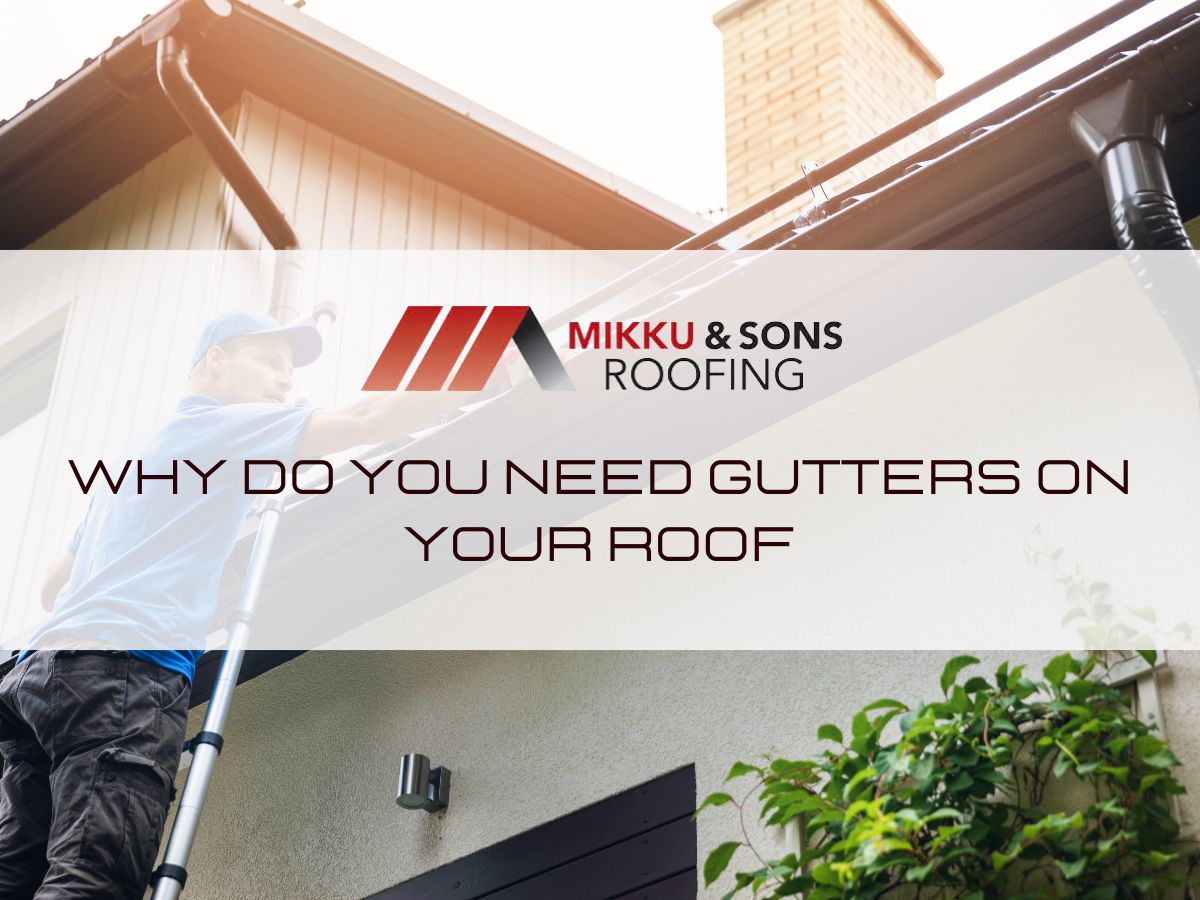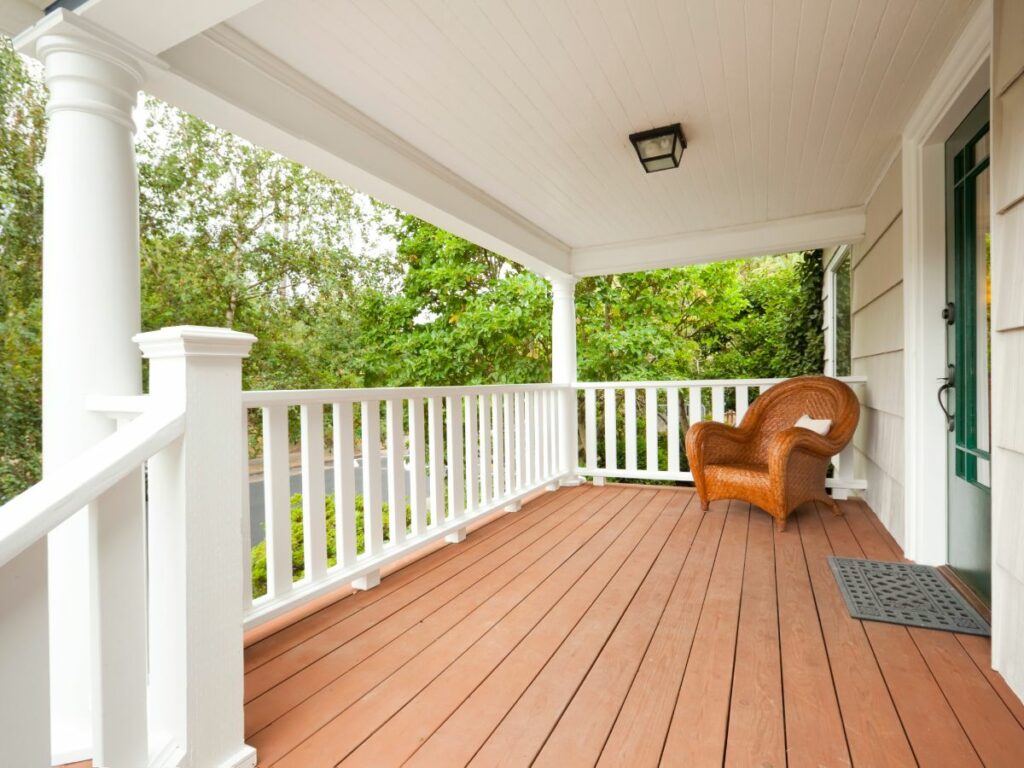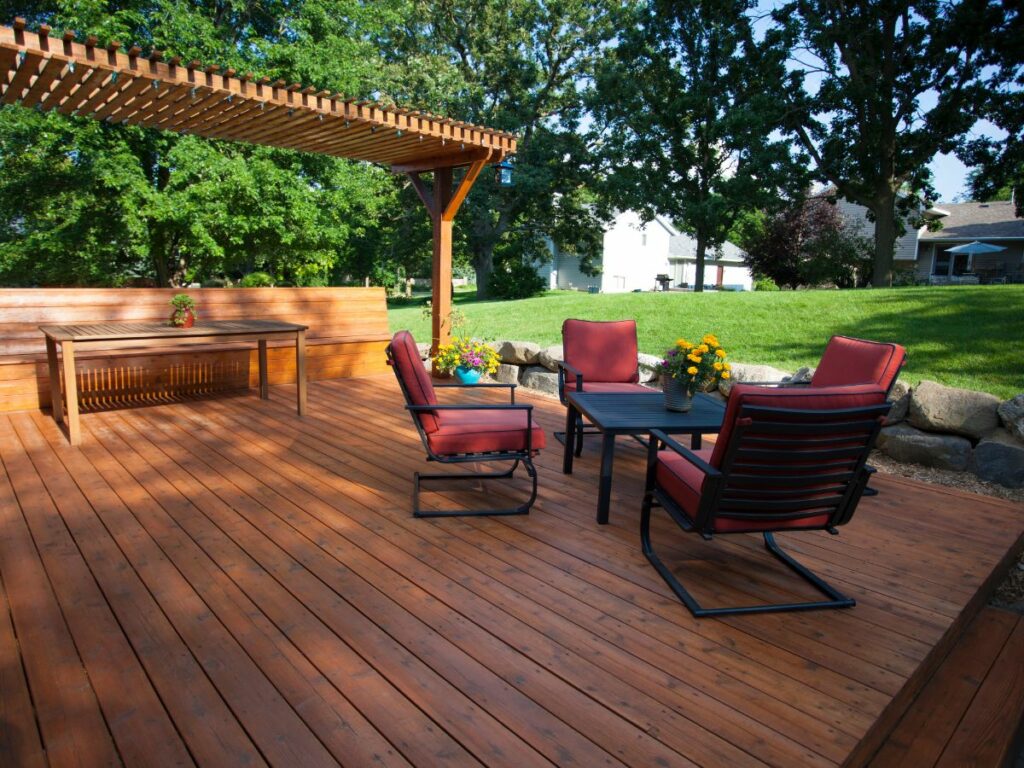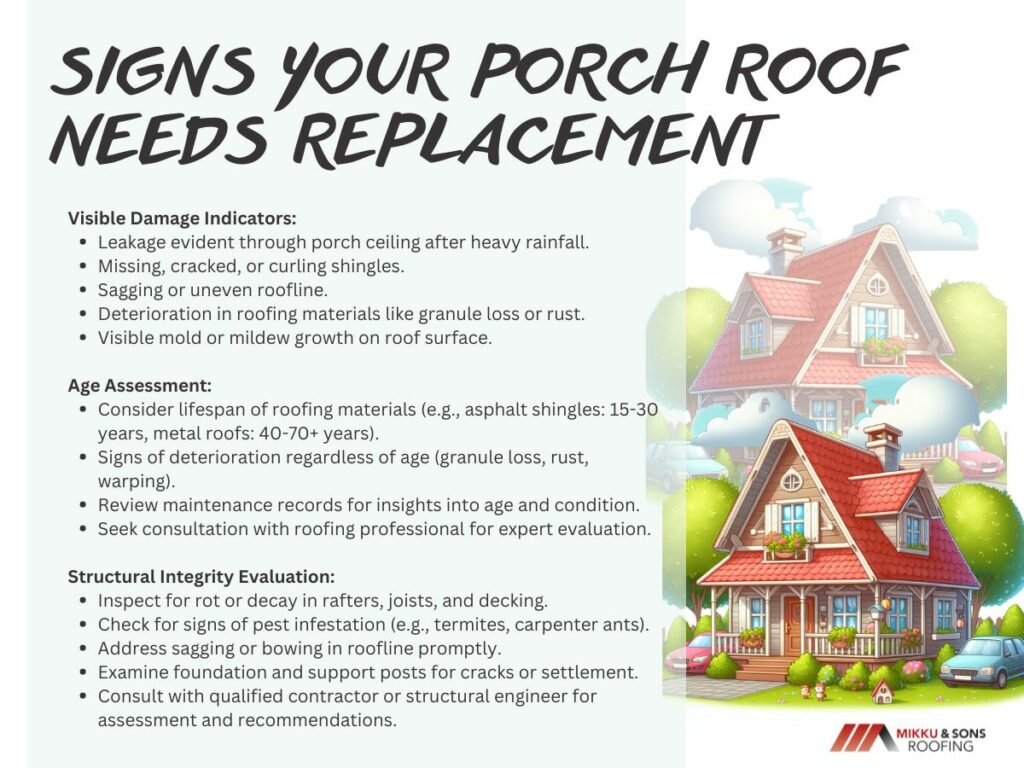

Your porch is more than just an outdoor space; it's an extension of your home, providing a cozy spot for relaxation, entertaining guests, or simply enjoying the fresh air. The roof over your porch plays a crucial role in protecting this cherished area from the elements, ensuring its longevity and functionality.
Whether your porch is covered, screened-in, or open-air, its roof is susceptible to wear and tear over time, necessitating periodic maintenance and, eventually, replacement. It's important to know when to repair your porch roof to protect your outdoor living area and avoid causing expensive damage to your house.
A porch is not a one-size-fits-all addition to a home; rather, it comes in various forms, each with its own unique characteristics and roofing requirements.
Covered porches are a popular choice among homeowners seeking sheltered outdoor spaces that provide protection from sun, rain, and other elements. Typically attached to the main structure of the house, these porches feature a roof that extends over the entire area, providing shade and shelter.

The roofing materials used for covered porches vary widely, ranging from traditional asphalt shingles to more durable options like metal or tile. Factors such as climate, budget, and aesthetic preferences often influence the choice of roofing material for covered porches.
Screened-in porches offer the best of both worlds: the enjoyment of outdoor living with the added benefit of protection from insects and other pests. These porches feature walls made of mesh or screen material, allowing for airflow while keeping unwanted critters at bay.

When it comes to roofing, screened-in porches present unique considerations due to their enclosed nature. The roof must not only provide protection from the elements but also integrate seamlessly with the screening to maintain the porch's functionality.
Common roofing materials for screened-in porches include shingles, metal panels, or even translucent panels to allow for natural light. However, ensuring proper ventilation is essential to prevent moisture buildup and potential damage to the porch structure.
Open-air porches, also known as patio decks or verandas, are characterized by their lack of enclosure, offering uninterrupted views of the surrounding landscape. While these porches provide an ideal space for outdoor dining, lounging, or entertaining, they are exposed to the full force of the elements, making their roofing needs particularly critical.

The roofing materials used for open-air porches must be durable enough to withstand exposure to sunlight, rain, wind, and temperature fluctuations. Common options include pressure-treated wood, composite decking, or specialized roofing membranes designed specifically for outdoor use.
Recognizing the signs that your porch roof requires replacement is essential for maintaining the integrity of your outdoor living space and preventing costly damage to your home.

When assessing your porch roof for visible damage, there are several key indicators to look for that may signal the need for replacement:
Water stains or moisture seeping through the ceiling of your porch are clear signs of roof damage. Inspect the interior of your porch regularly for any signs of water infiltration, especially after heavy rainfall or snowmelt.
Examine the surface of your porch roof for any missing, cracked, or curling shingles, or damaged panels. These issues can leave your roof vulnerable to water penetration and further deterioration.
A sagging or uneven roofline may indicate structural damage or weakening of the porch roof's support system. Inspect the exterior of your porch roof for any visible signs of sagging or dips in the roofline, and address these issues promptly to prevent further damage.
Look for signs of deterioration in the roofing materials themselves, such as granule loss on asphalt shingles, rust on metal roofs, or warping on wood shingles. These signs can indicate that the roof is reaching the end of its lifespan and may need replacement soon.
Mold or mildew growth on the surface of your porch roof can indicate underlying moisture problems, which can lead to rot and structural damage if left unchecked. If you notice any signs of mold or mildew, it's essential to address the issue promptly to prevent further damage to your roof and the surrounding structure.
Assessing the age of your porch roof and understanding the expected lifespan of its roofing materials are essential factors in determining whether replacement is necessary:
Different roofing materials have varying lifespans, and knowing the type of material used on your porch roof can help gauge its expected longevity. For example, asphalt shingles typically last 15 to 30 years, while metal roofs can endure 40 to 70 years or more with proper maintenance.
Understanding the expected lifespan of your porch roof's roofing material can provide insight into when replacement may be warranted.
Even if your porch roof hasn't reached the end of its expected lifespan, signs of deterioration may indicate that replacement is necessary sooner rather than later. Look for indications such as granule loss on asphalt shingles, rust on metal roofs, or warping on wood shingles, as these can signal that the roofing material is beginning to degrade and may no longer provide adequate protection.
Reviewing any maintenance records or documentation related to your porch roof can provide valuable insights into its age and condition. If previous repairs or replacements were performed, it can help establish a timeline for when the current roof was installed and when replacement may be due.
If you're unsure about the age or condition of your porch roof, it's advisable to consult with a qualified roofing professional. They can assess the current state of your roof, provide guidance on its expected lifespan based on the type of roofing material used, and recommend whether replacement is necessary based on their findings.
Structural integrity is paramount when assessing the need for porch roof replacement, as any compromised components can pose significant risks. Here's how to evaluate structural issues:
Begin by inspecting the structural components of your porch roof, including rafters, joists, and decking, for signs of rot or decay. Wood exposed to moisture can deteriorate over time, compromising the stability of the entire roof structure.
Look for soft or spongy areas, discoloration, or visible signs of fungal growth, which may indicate rot or decay.
Insects such as termites or carpenter ants can cause extensive damage to the wooden components of your porch roof, weakening its structure and posing a safety hazard. Inspect the wood for any signs of insect activity, such as small holes, sawdust, or hollow-sounding areas.
If you suspect a pest infestation, it's crucial to address the issue promptly to prevent further damage and potential collapse of the roof structure.
A sagging or bowing roofline is a clear indication of structural instability and should be addressed immediately. Inspect the exterior of your porch roof for any visible signs of sagging, particularly along the ridge line or in areas where the roof meets the main structure of the house.
You should also, check the interior of your porch for any signs of sagging or bowing in the ceiling, which may indicate underlying structural issues.
Cracks in the foundation or settlement of the porch structure can affect the integrity of the roof above. Inspect the foundation and support posts for any signs of cracking, shifting, or settling, which may indicate structural instability.
If you notice any significant cracks or settlement, it's essential to consult with a structural engineer or qualified contractor to assess the extent of the damage and recommend appropriate repairs or reinforcements.
If you identify any structural issues during your inspection, it's crucial to consult with a qualified contractor or structural engineer to assess the severity of the problem and determine the best course of action. Structural issues can compromise the safety of your porch roof and pose significant risks to occupants, so it's essential to address them promptly and thoroughly.
While regular maintenance and timely repairs can often prolong the lifespan of your porch roof, certain circumstances may necessitate immediate replacement to prevent further damage or safety hazards.

Severe weather events such as storms, hurricanes, or heavy snowfall can wreak havoc on porch roofs, causing significant damage and posing safety risks. Here's why it's crucial to address severe weather damage promptly:
Severe weather can cause sudden and extensive damage to porch roofs, including missing shingles, structural compromise, or even complete collapse. If your porch roof has been impacted by a severe weather event, it's essential to assess the extent of the damage and address any immediate threats to safety or structural integrity.
Severe storms can lead to water infiltration through compromised roof surfaces, resulting in leaks, water damage, and mold growth. Prompt repair or replacement of damaged areas can prevent further water infiltration and mitigate the risk of structural damage or mold-related health issues.
Ignoring severe weather damage can lead to further deterioration of the porch roof and surrounding structure. Leaks and water infiltration can cause rot, decay, and structural weakening over time, resulting in costly repairs or even the need for full roof replacement.
If your porch roof has sustained damage due to a severe weather event, it's essential to document the damage and contact your insurance provider promptly. Many homeowner's insurance policies cover damage caused by severe weather, but timely reporting and documentation are essential for filing a successful claim.
Safety hazards associated with compromised porch roofs require immediate attention to mitigate risks and ensure the well-being of occupants and visitors. Here's why addressing safety hazards promptly is crucial:
A compromised porch roof, whether due to severe weather damage, structural issues, or deterioration over time, poses a significant risk of collapse. Weak or damaged roof components can fail suddenly, endangering anyone in the vicinity and potentially causing serious injury or even fatalities.
Loose or missing shingles, deteriorating roofing materials, and sagging areas can result in falling debris, posing a hazard to individuals below. Flying debris during severe weather events can also cause injury or property damage.
Porch roofs often house electrical wiring for lighting fixtures, fans, or outlets. Damage to the roof structure or water infiltration can compromise electrical systems, increasing the risk of electrical shock or fire.
If you suspect damage to electrical components within your porch roof, it's essential to disconnect power and consult with a qualified electrician to assess and address the issue safely.
Water infiltration through a compromised porch roof can create slippery surfaces, increasing the risk of slip and fall accidents for occupants and visitors. Mold or mildew growth resulting from water damage can also worsen these risks.
As a homeowner, you have a legal obligation to maintain a safe environment on your property for guests and visitors. Neglecting safety hazards associated with a compromised porch roof can expose you to legal liability in the event of accidents or injuries.
Maintaining a strong and reliable porch roof is essential for preserving the integrity and functionality of your outdoor living space. Through regular inspections, proactive maintenance, and timely repairs or replacements, you can ensure that your porch roof continues to provide protection and enjoyment for years to come.
One crucial aspect to consider when evaluating your porch roof is its pitch or slope. The pitch of your roof plays a significant role in determining its ability to shed water and withstand the elements effectively.
Different roof pitches are suited to different climates and conditions, and understanding how roof pitch can affect your home is essential for making informed decisions about porch roof replacement.
